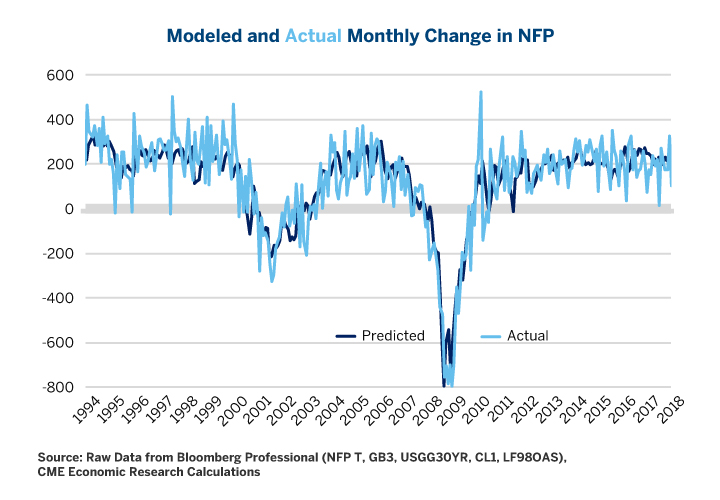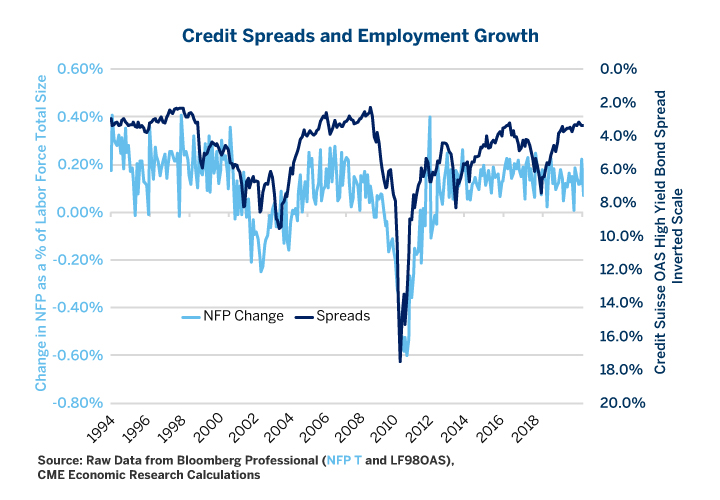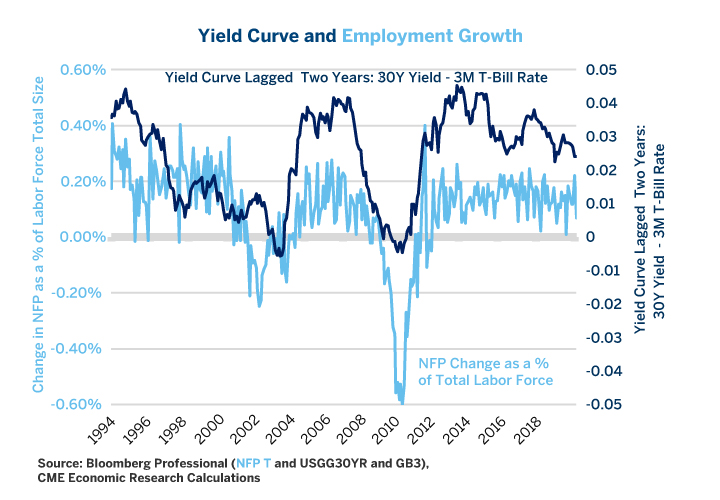29 May 2018 By Erik Norland Topics: Economic Events
Forget for a moment about the May employment report due out on June 1. We have something much more interesting than the 195K consensus estimate for non-farm payrolls (NFP) in May. Using just three factors, our model forecasts not only May’s result but also produces a preliminary estimate for the June payroll report out on July 6. This model explains approximately 70% of the future variance in the NFP, enabling for forecasts over one month in advance.
Over the past quarter century, three factors have explained 70% of the monthly variation in the NFP series (Figure 1). If one knows 1) the spread between high-yield corporate bonds and U.S. Treasuries, 2) the shape of the yield curve, and 3) changes in oil prices as well as the model’s previous forecasting errors, one is more than two-thirds of the way to knowing the result of the next NFP report.
Figure 1: Credit Spreads, Yield Curve, Oil Prices and Previous Forecast Error Explain 70% of NFP Changes.

Credit Spreads
Of the various factors, credit spreads are by far the most important, explaining almost 60% of the month-to-month changes in the NFP. Moreover, credit spreads influence the employment market with a short lag of about one month. A narrowing of credit spreads this month correlates to an increase in hiring next month. By contrast, a widening of credit spreads often portends an abrupt slowdown in hiring (Figure 2). This isn’t too surprising. Narrow credit spreads imply that companies can readily obtain financing from the capital markets, enabling them to invest in and expand operations which often necessitate hiring staff as well as boost hiring at their suppliers. By contrast, when credit spreads blow out, as they did between 1998 and 2002, and again in the 2007-2009 period, hiring comes to an abrupt halt and companies begin downsizing.
Our model suggests that a 1% widening of credit spreads will, on average, slow employment growth by about 70K jobs per month. If the economy is adding say, 200K jobs per month on average, it would take about a 3% widening of credit spreads for that growth to grind to a halt.
Figure 2: Narrow Credits Spreads are Good for Labor Markets.

While credit spreads are an important indicator of the health of the labor market in the days ahead, they are by no means infallible. For example, a widening of credit spreads in 2015 and 2016 didn’t derail the economic recovery in large part because credit problems were confined to just one sector: energy. As oil prices fell by 70% between November 2014 and February 2016, credit spreads blew out in the energy sector, which underwent a severe restructuring. Lower oil prices, however, was great news for most other sectors of the economy, including consumer spending. Overall hiring continued apace. Moreover, the 2015 and 2016 widening of spreads occurred during a steep yield curve environment and economic downturns almost never occur when yield curves are positively sloped (when long-term rates are higher than short-term rates).
Yield Curves
The U.S. has not experienced a recession without first having a flat or inverted yield curve in over five decades. Indeed, the slope of the yield curve is not only a strong indicator of future GDP growth but it also explains about 30% of the variation in the NFP just by itself. What’s particularly astonishing about that statement is that the yield explains that variation in the NFP two years in advance (Figure 3). In other words, a steep yield curve today essentially forecasts employment gains two years from now. By contrast, a flat yield curve in 2018 would imply stagnant employment markets or even a recession in 2020.
Figure 3: Yield Curve Slope Correlates to Employment Growth Two Years in the Future.

Fiscal Policy
A 1% flattening of the yield curve will, according to our model, slow employment growth by about 30K per month, on average, two years hence. In the past two years, for instance, the yield curve has flattened from a 260-basis-point (bps) spread between the 3M and 30Y to about 130 bps. This could slow employment growth by 40,000 per month as we move into 2020. Should the Federal Reserve (Fed) continue to tighten monetary policy and bring the yield curve to being flat by 2020, which is about what the forward curve suggests is likely, that would shave off monthly employment growth by 80,000 jobs by 2021 or 2022. This would make the labor market more vulnerable to a downturn if credit spreads also widened out.
It’s important to remember that the impact of the yield curve described here is its impact in consideration with other factors and not in isolation. As we have noted in our previous research, the yield curve is involved in a cycle with both unemployment and the yield curve. Flat yield curves tend not only to be associated with subsequent downturns in labor markets but also with severe and sustained widenings of credit spreads – a potential double whammy for the labor market.
Oil Prices
Changes in the price of crude oil explain about 7% of future employment growth by themselves. One might wonder why bother to include a factor that explains so little of the variation on employment on its own. The answer is that it helps during times like in 2015 when credit spreads were suggesting a downturn that didn’t materialize because the energy-related blowout in credit spreads was isolated to the energy sector and did not envelope the economy, which was mostly being helped by lower input costs. Moreover, including energy prices also helps to explain why the 2003-2007 recovery was so anemic in terms of employment growth and why the subsequent downturn was so severe. Between 2003 and 2007, oil prices soared from $35 to $145 per barrel, impeding the recovery from the 2001 recession and perhaps serving as the unsung villain of the 2008 financial crisis.
In terms of our model, a 70% drop in oil prices, such as the one between late 2014 and early 2016, should be enough to improve employment growth by about 150,000 jobs per month. That proved enough to offset nearly half the employment losses expected from the widening of credit spreads during that period. A steep yield curve in 2013 and 2014 provided additional buffer and kept the economy growing despite the severe distress of the energy sector.
Outlook and Yield Curve and Credit/Employment Cycles
For the moment, the most important of the three indicators – credit spreads — is pointing towards continued growth in employment. The fact of oil prices rising and the yield curve flattening could slow the employment market’s progress in years to come, however, even if spreads remain tight.
For the recent April employment report, the model forecasted job gains of 236K +/-88K jobs standard deviation. Set aside the April report for a moment. This model is forecasting 227K +/-89K for June (Figure 4) based upon credit spreads, oil price movements and lagged yield curve data available at the end of April and it will probably be roughly as accurate as the consensus forecast of economists.
Figure 4: This Model Can Forecast the May 2018 Employment Gains Using April 2018 Factor Data.
| Variable | Coefficients | Standard Error | t Stat | P-value | Factor Value for June | Labor Force Size in Thousands | May Forecast Contribution | Regression Statistics | |
| Intercept | 0.0028 | 0.000219 | 12.83 | 5.41E-30 | 1 | 148230 | 416 | Multiple R | 0.84552 |
| Credit Spreads | -0.047 | 0.002753 | -17.06 | 2.20E-45 | 3.33% | 148230 | -232 | R Square | 0.7149 |
| Oil Prices | -0.0011 | 0.000207 | -5.21 | 3.72E-07 | 13.10% | 148230 | -21 | Adjusted R Square | 0.70886 |
| Yield Curve | 0.0205 | 0.004459 | 4.59 | 6.58E-06 | 2.24% | 148230 | 68 | Standard Error | 0.00088 |
| Residual 1 | 0.2471 | 0.058967 | 4.19 | 3.71E-05 | -0.07% | 148230 | -27 | Observations | 290 |
| Residual 2 | 0.231 | 0.059634 | 3.89 | 0.000124 | 0.08% | 148230 | 27 | ||
| Residual 3 | 0.1396 | 0.059112 | 2.36 | 0.018865 | -0.03% | 148230 | -5 | ||
| Source: Cme Economic Resarch Calulations | My 2018 Forecast: | 227 | +/- 89 One Standard Deviation | ||||||
Longer term, it’s important to realize that unemployment, credit spreads and the yield curve are all deeply intertwined. The yield curve has a similar relationship with credit spreads as it has with unemployment. In a nutshell, when the yield curve becomes flat, it tends to lead to widening credit spreads with a one-to-two-year lag and a sharp rise in unemployment with a similar delay. If the Fed keeps tightening at anywhere near its suggested pace, it will likely bring the yield curve to being flat by the end of the decade and this could create an explosive widening of credit spreads which could, in turn, create steep job losses in the early 2020s.
Oil represents a two-way risk for employment. If soaring U.S. production and a possible breakdown in discipline on the part of OPEC cause prices to fall again, this should be supportive for jobs. By contrast, any instability in oil-producing nations or any intensification of conflicts in the Middle East could potentially send oil prices soaring, to the detriment of job creation. Our model suggests that each 10% upward move in oil prices probably causes about 16K fewer jobs to be created each month. That’s not too bad, but if oil prices double or triple, as they did in 1973 and 1979, it could severely damage the American job creation engine.
Bottom Line
- Our model explains over 70% of month-to-month changes in NFP and can forecast it one month in advance.
- With narrow credit spreads and steep yield curves over the past few years, the U.S. economy looks set to create jobs at a robust pace in the months ahead.
- As the yield curve flattens, the risks of an explosion in credit spreads and a sharp drop in job creation are increasing, especially towards 2020 and 2021.

